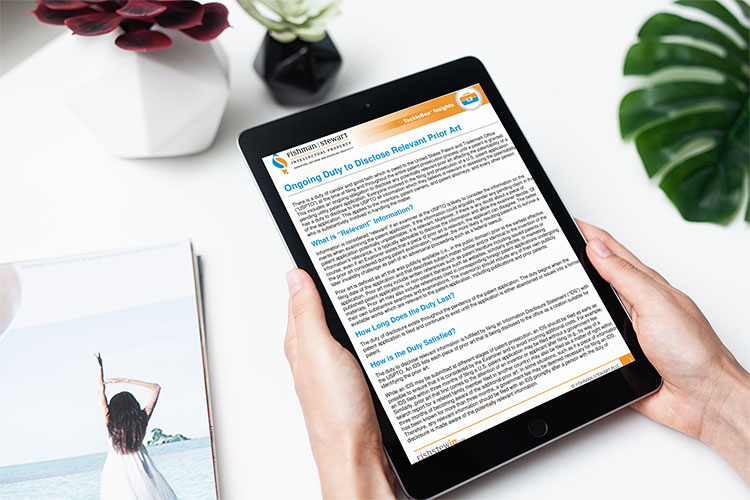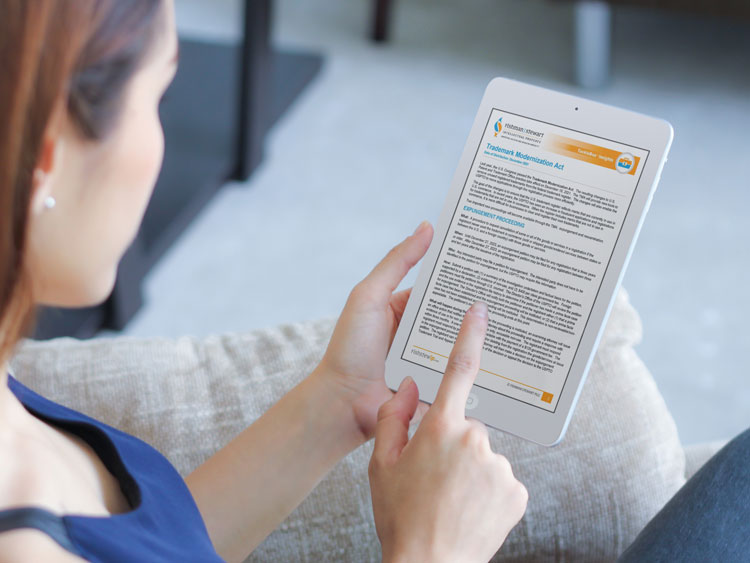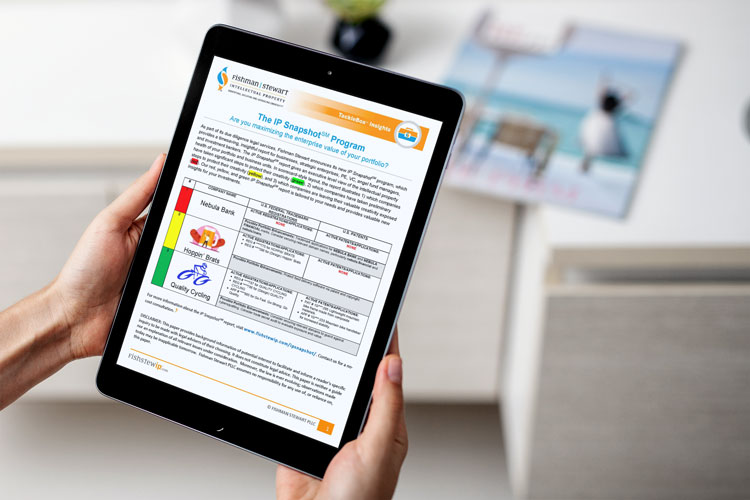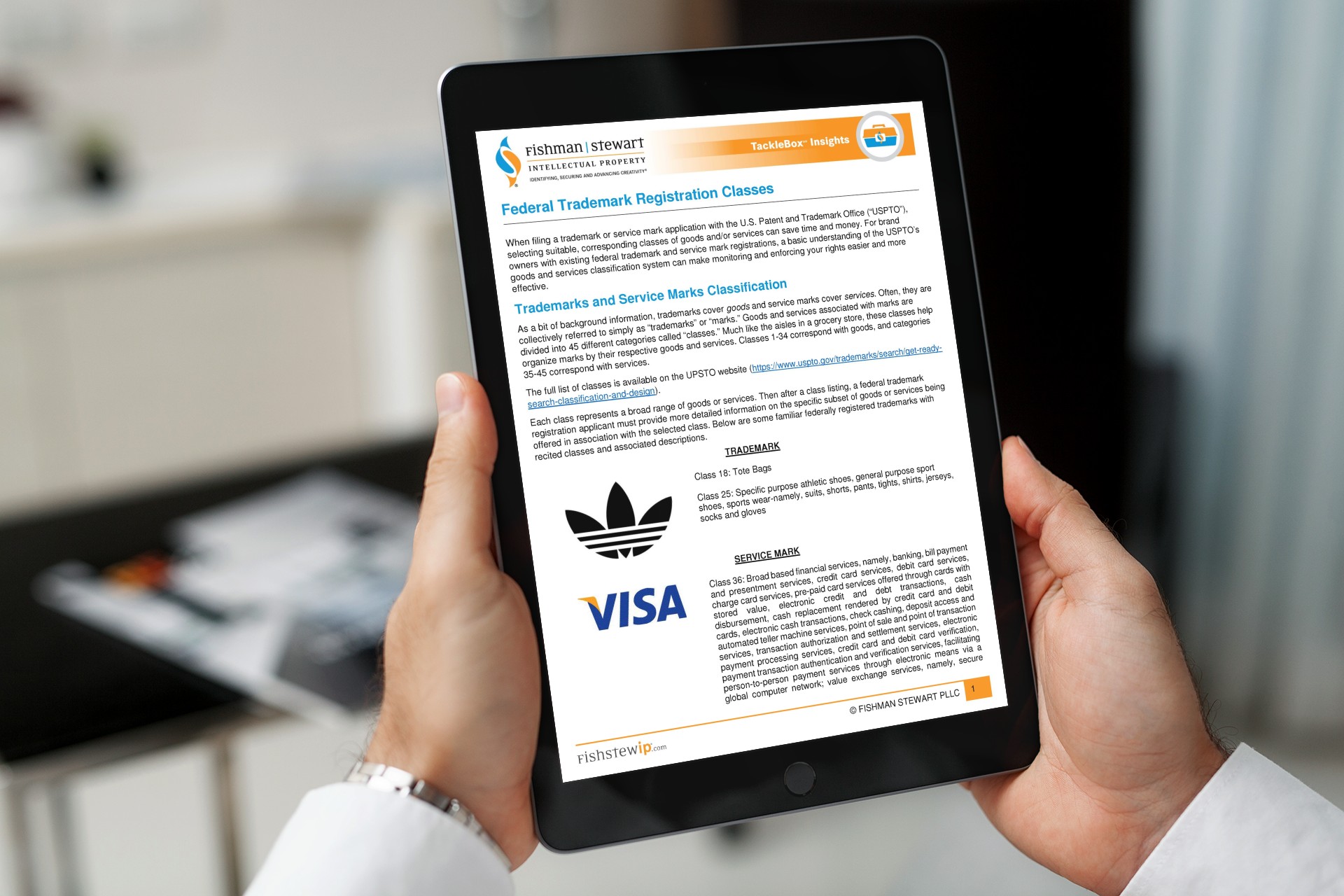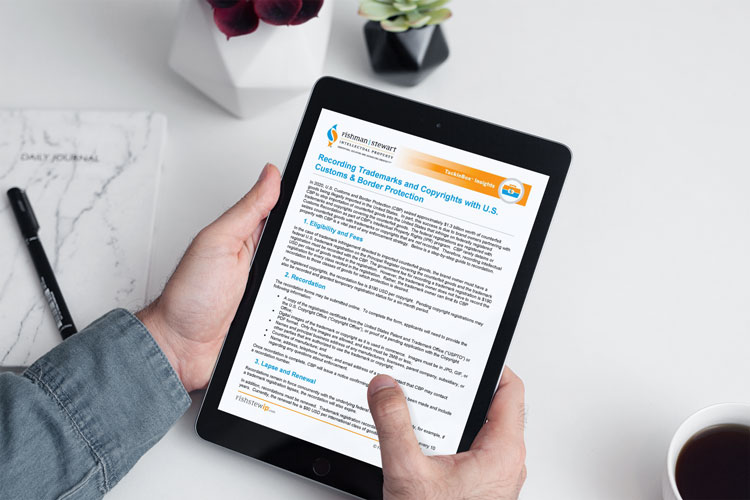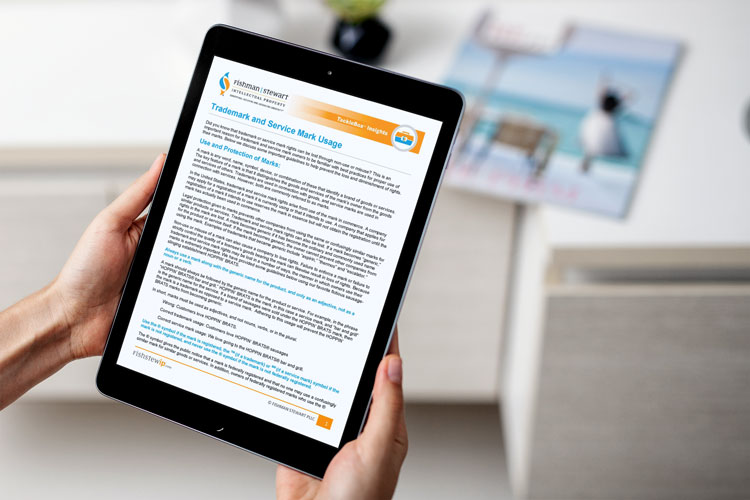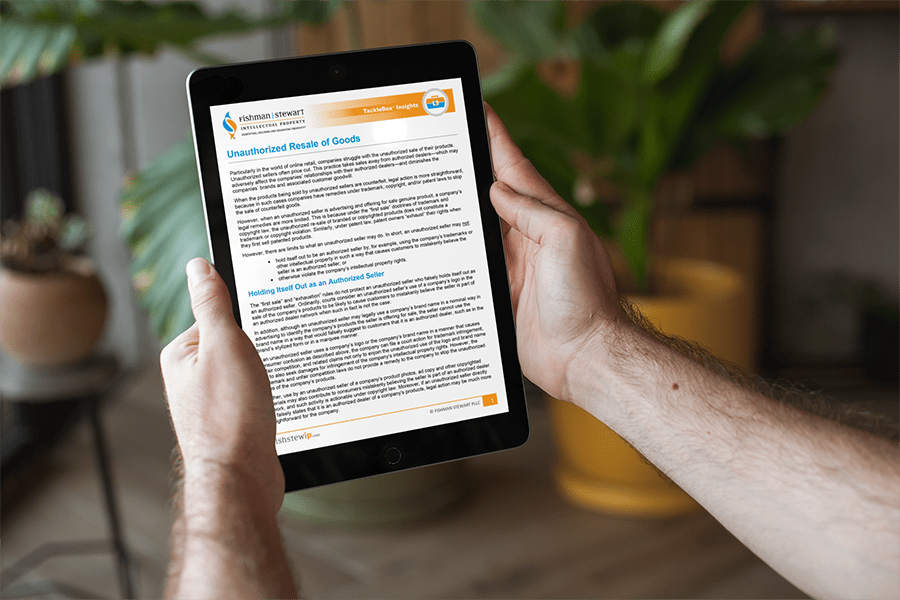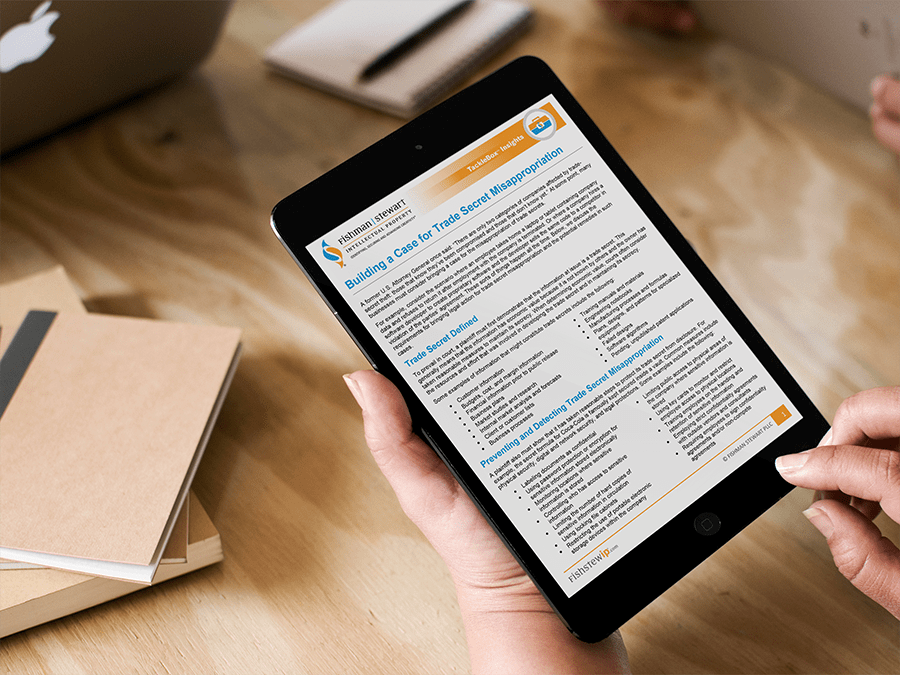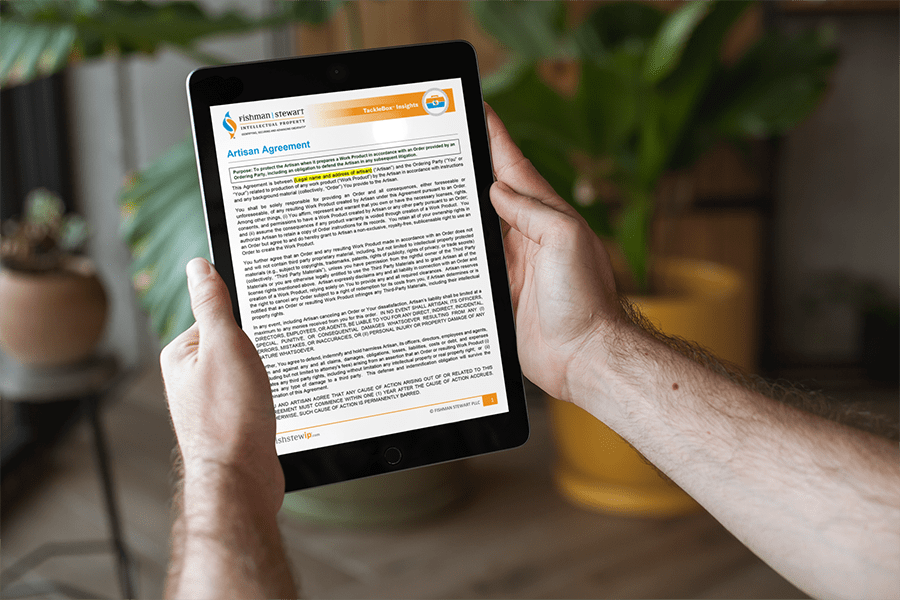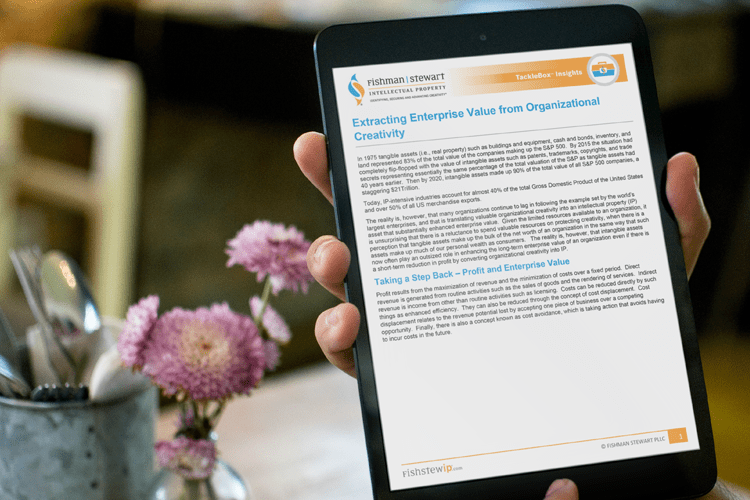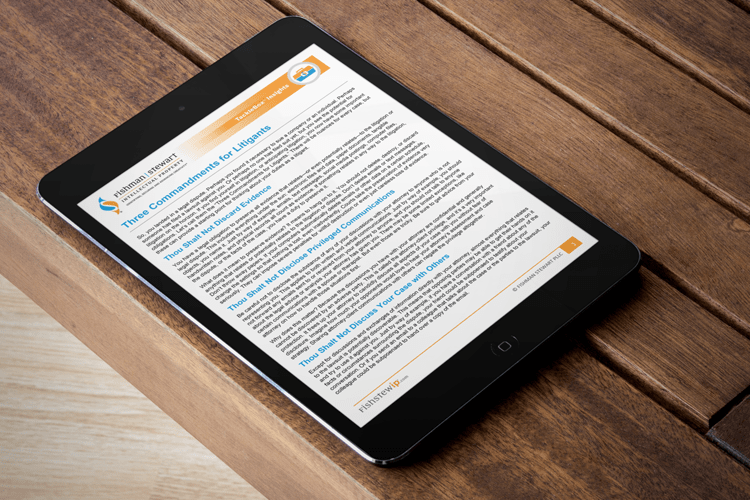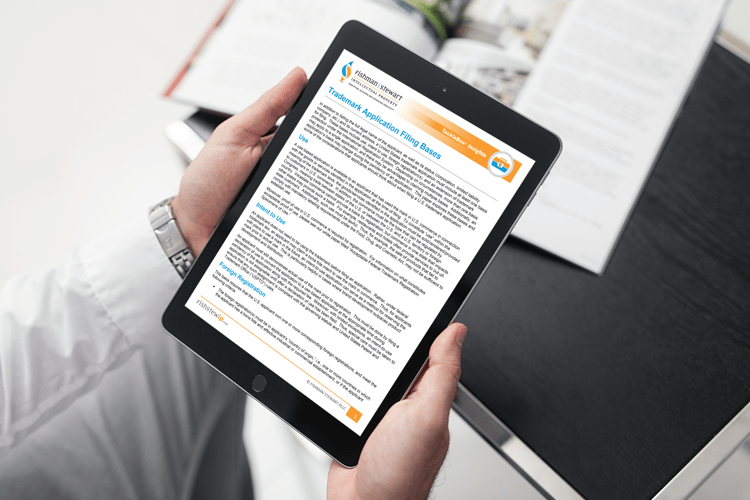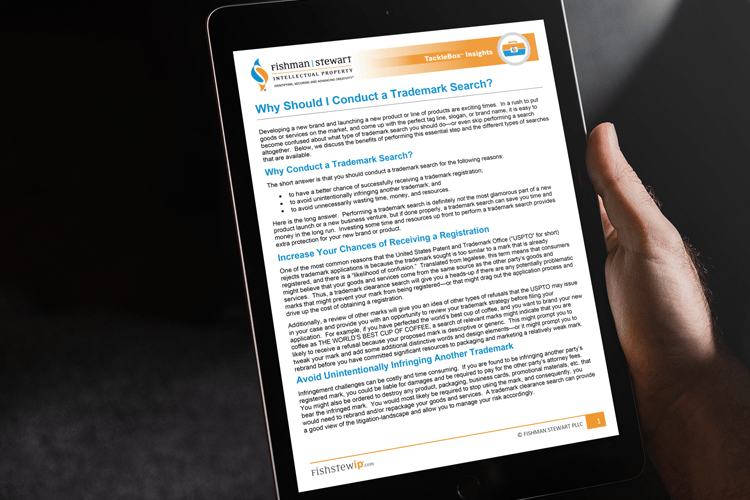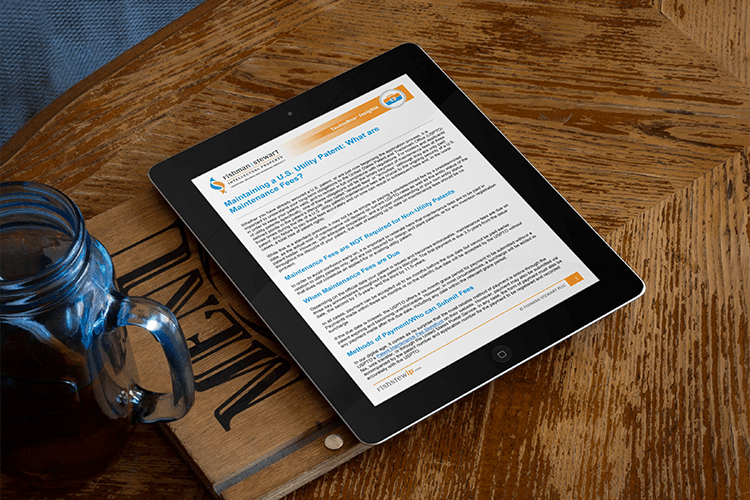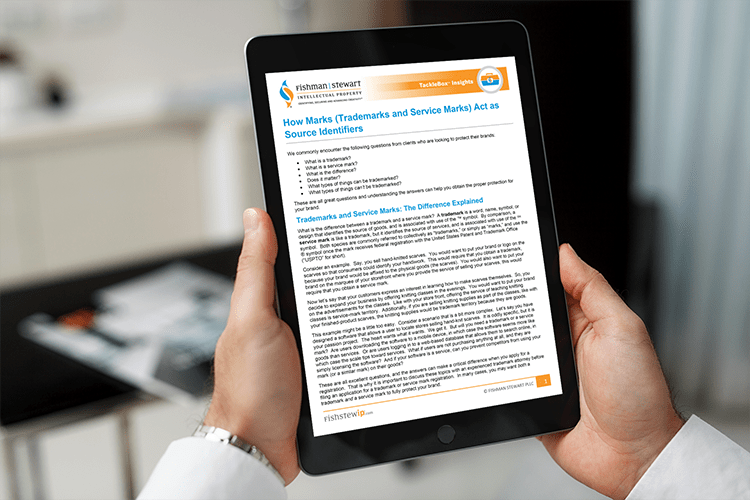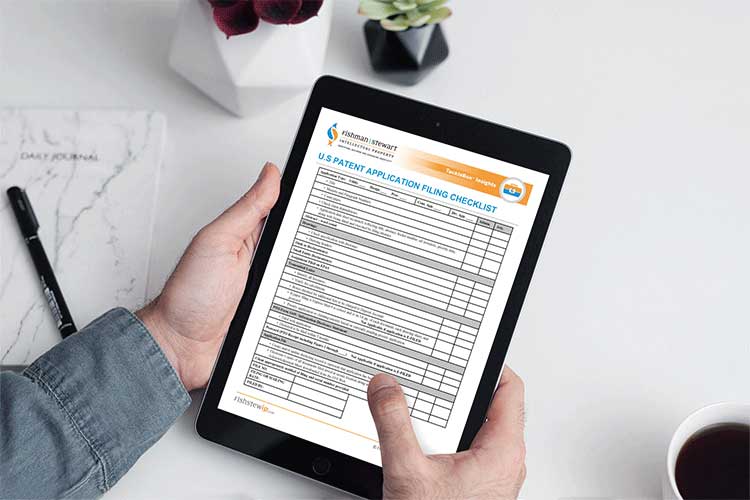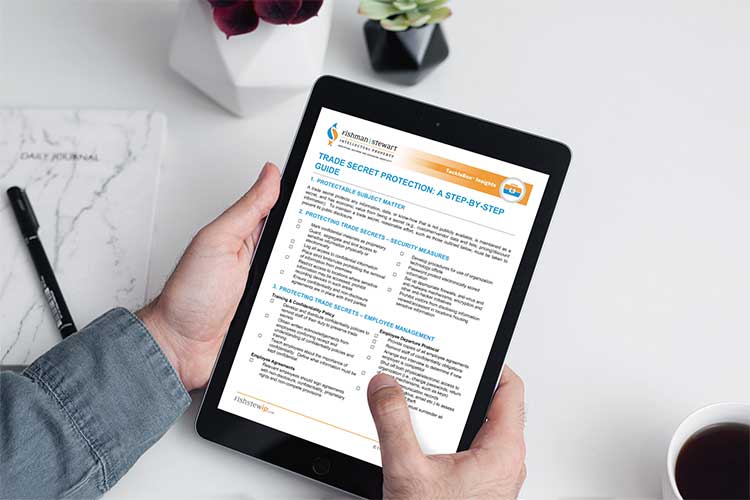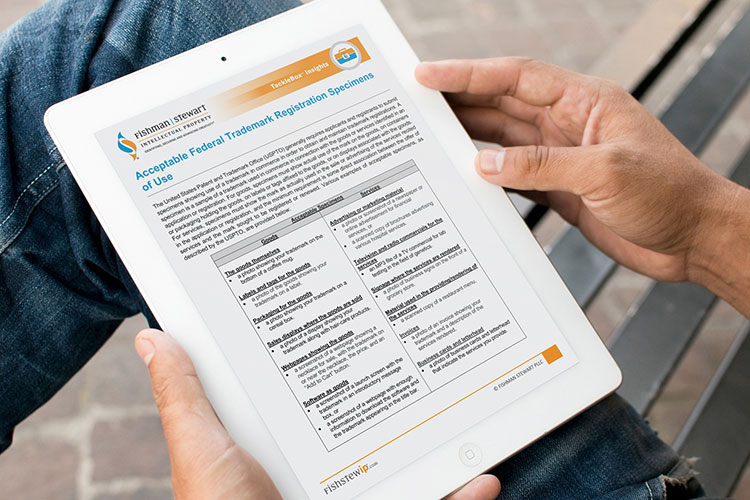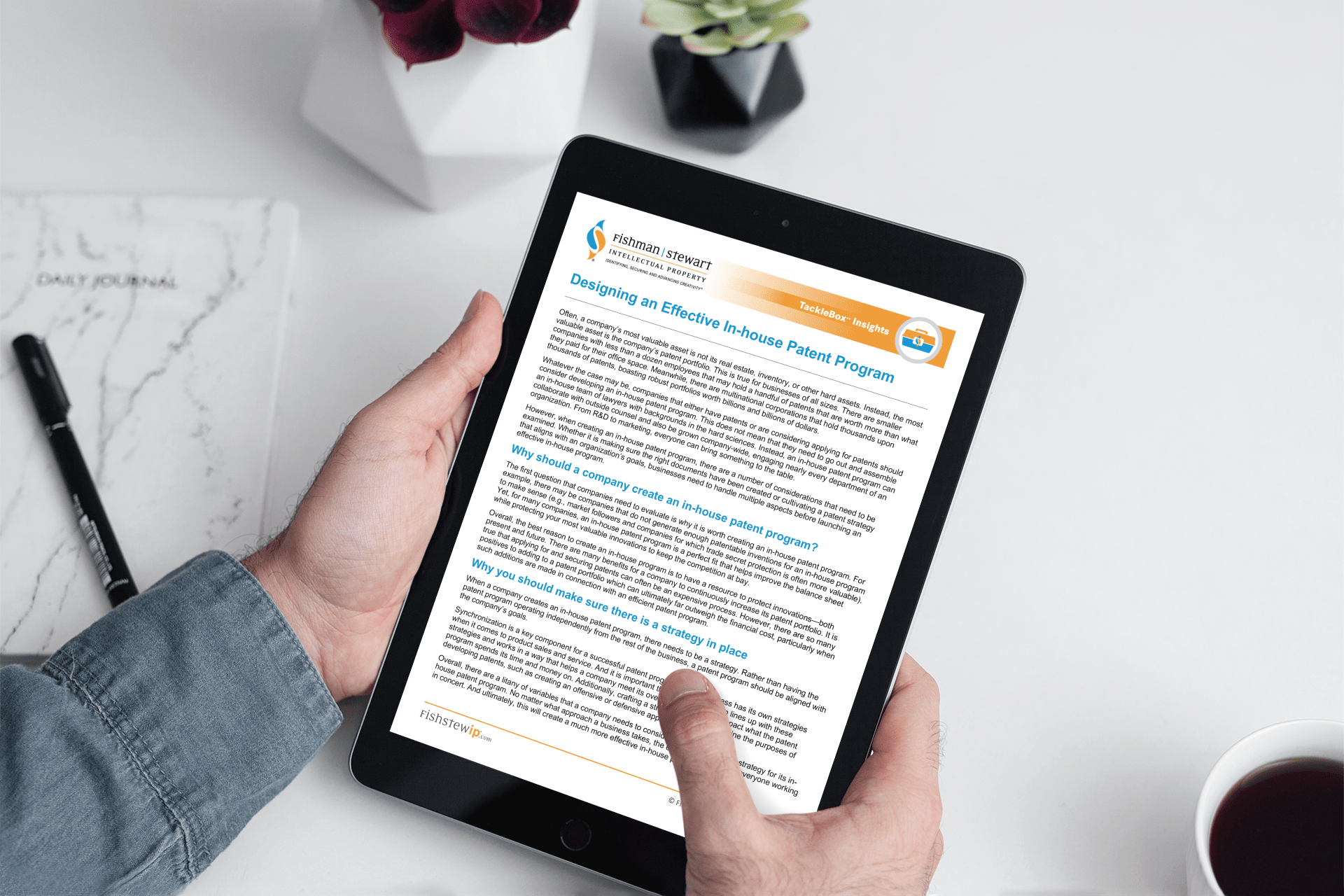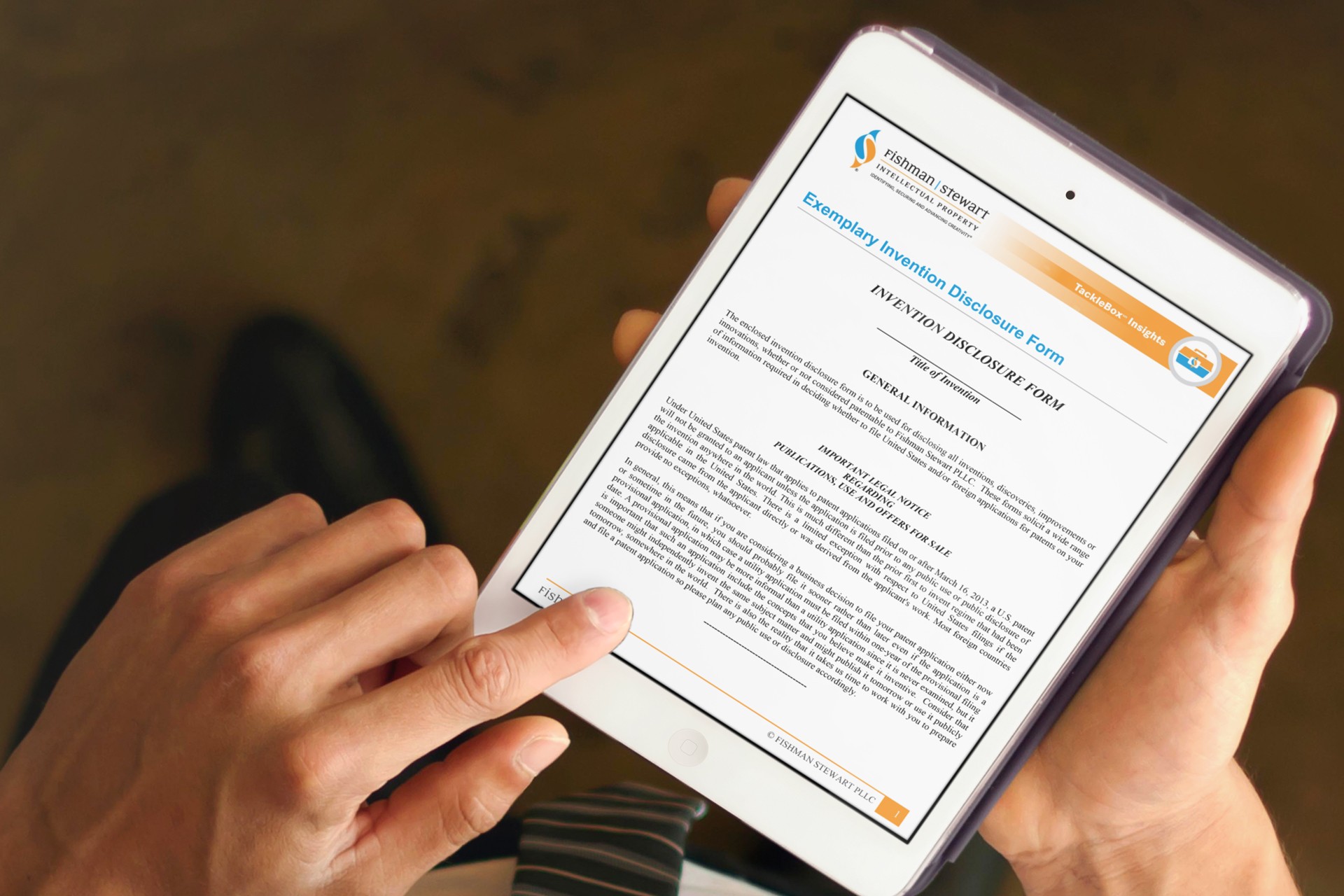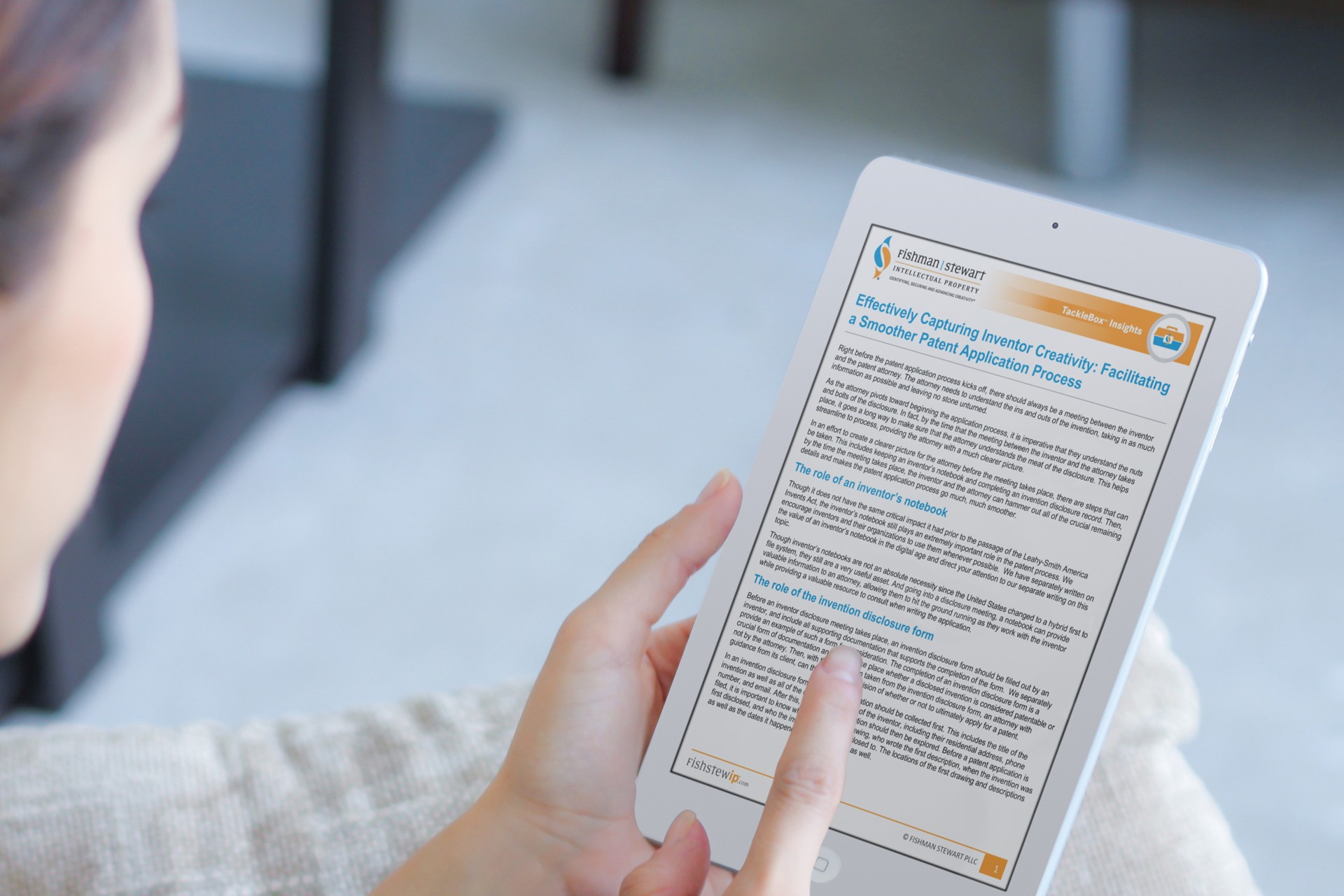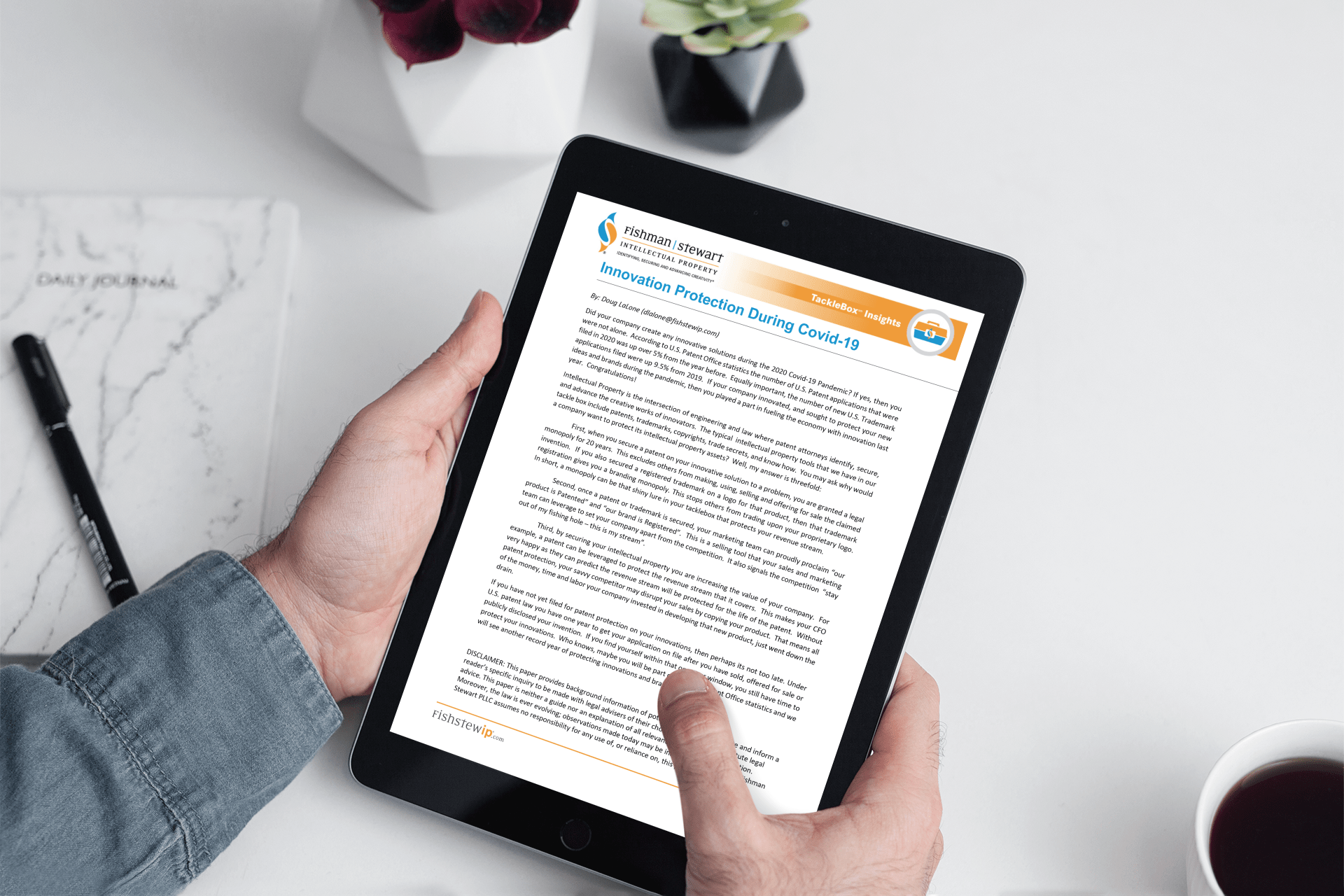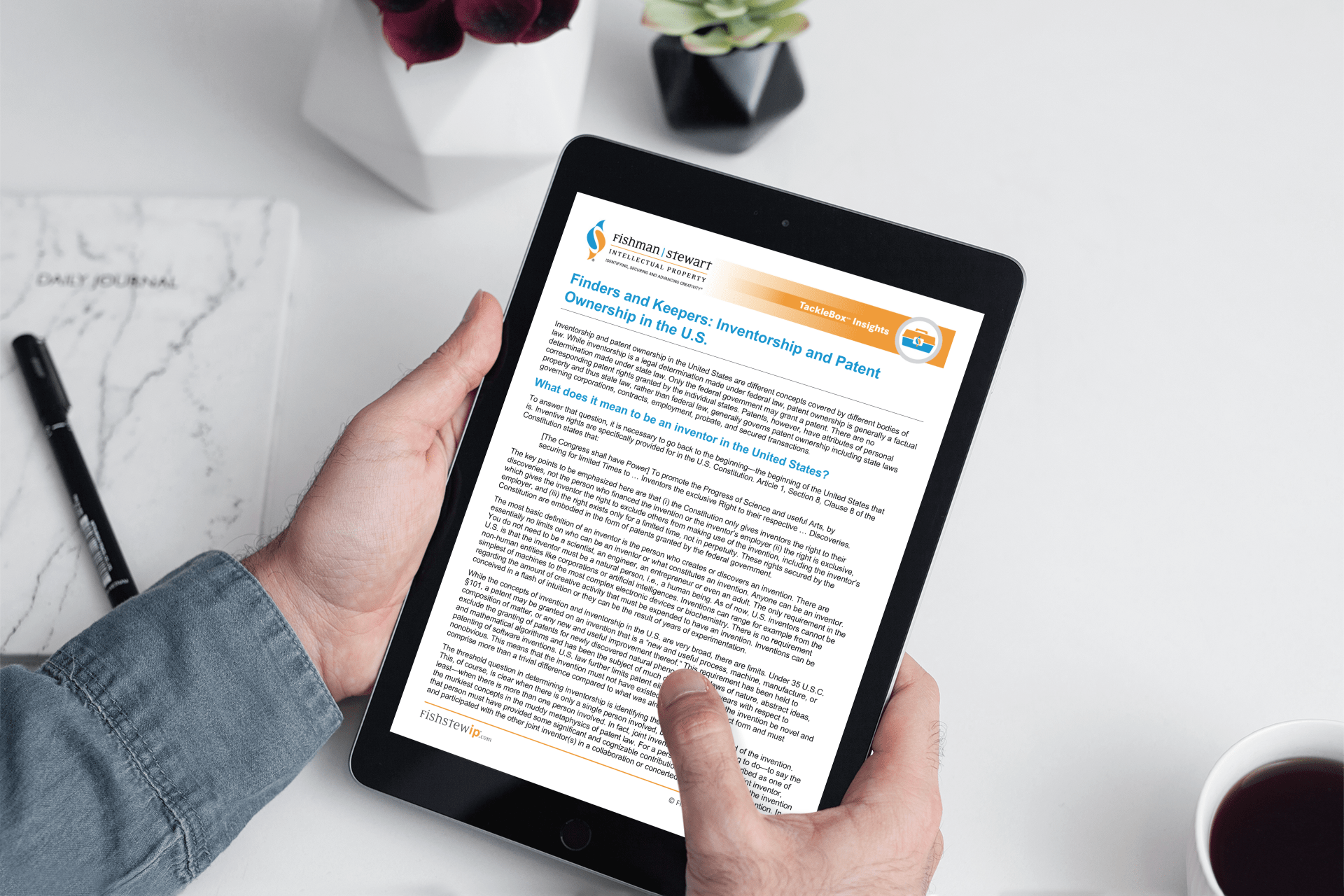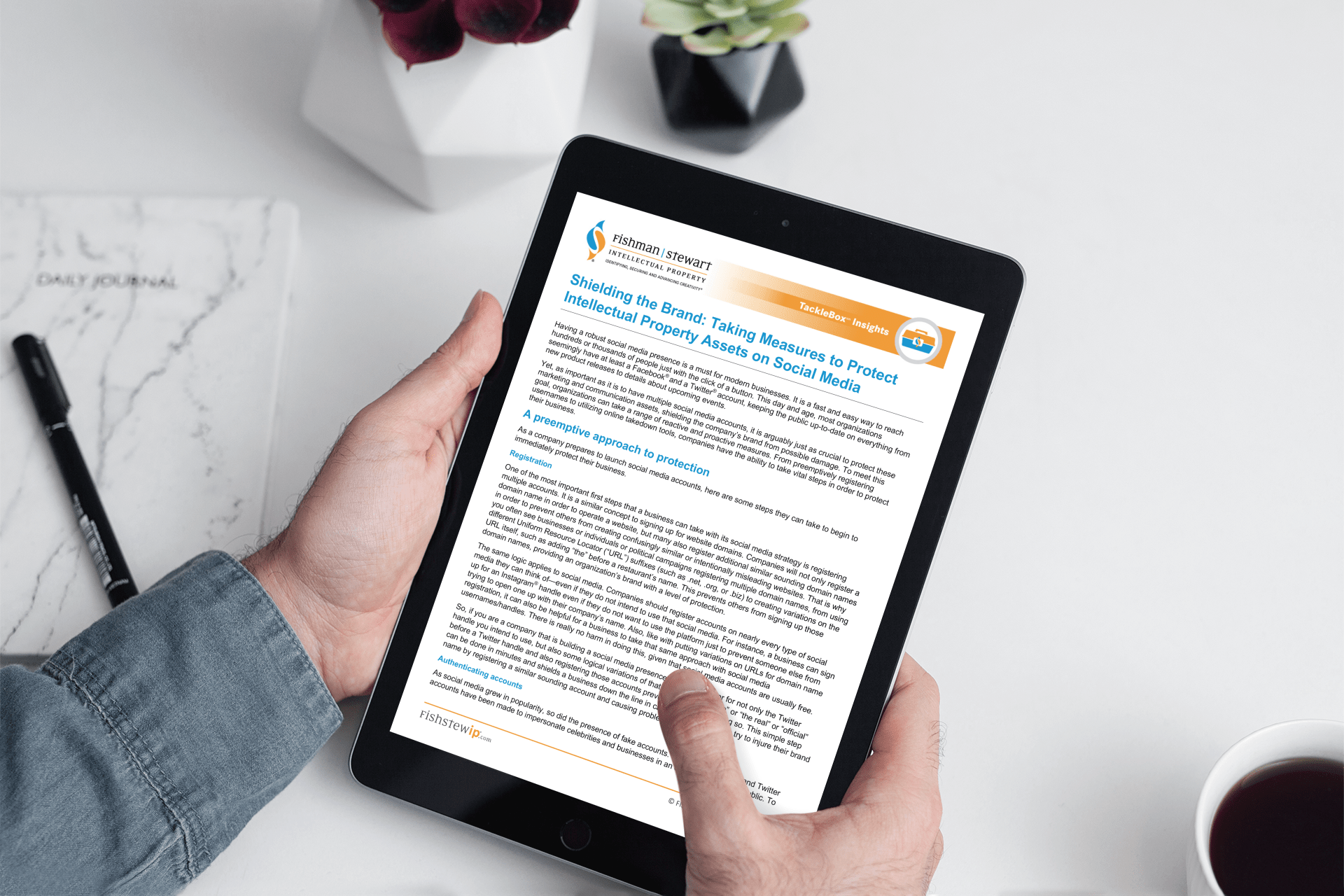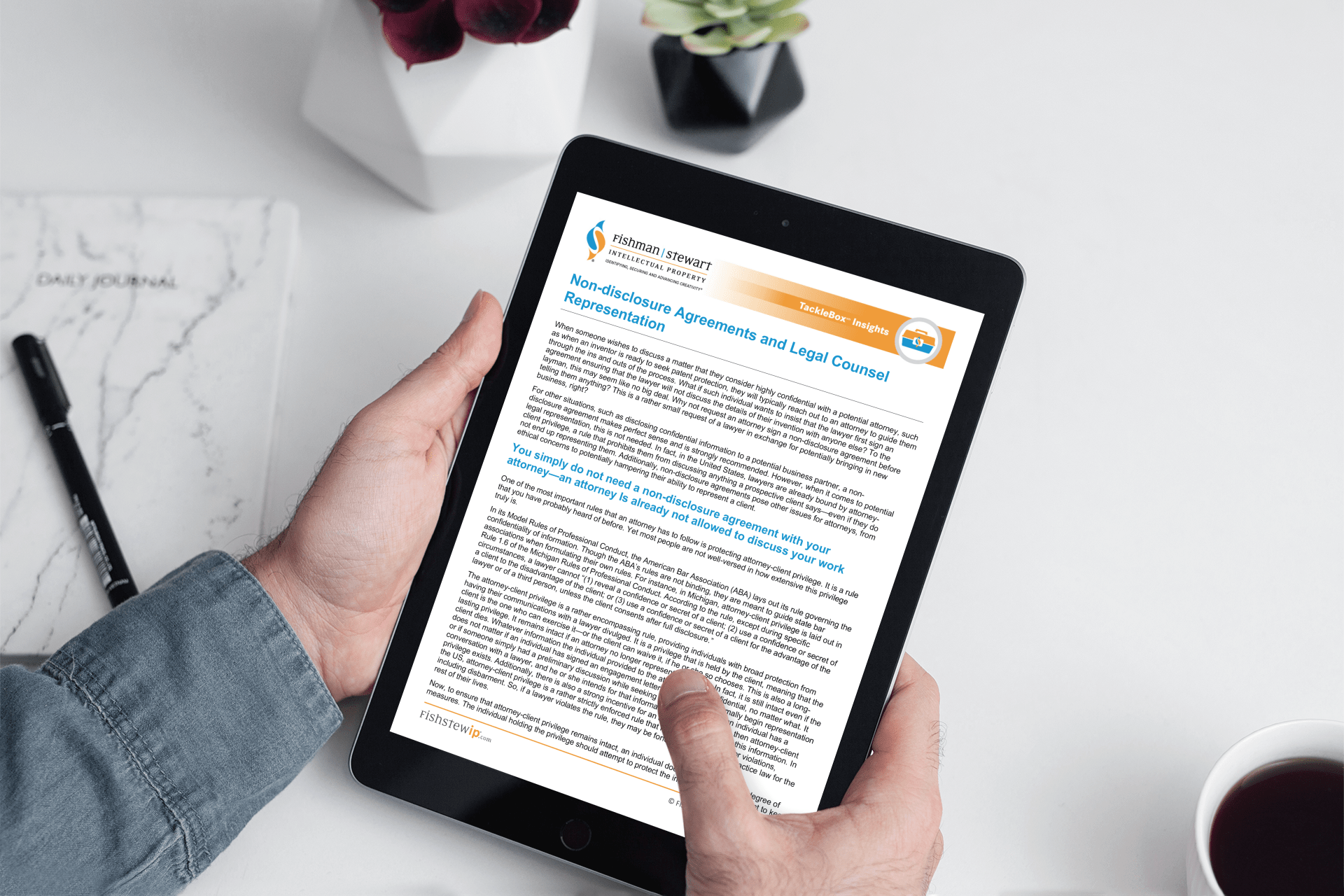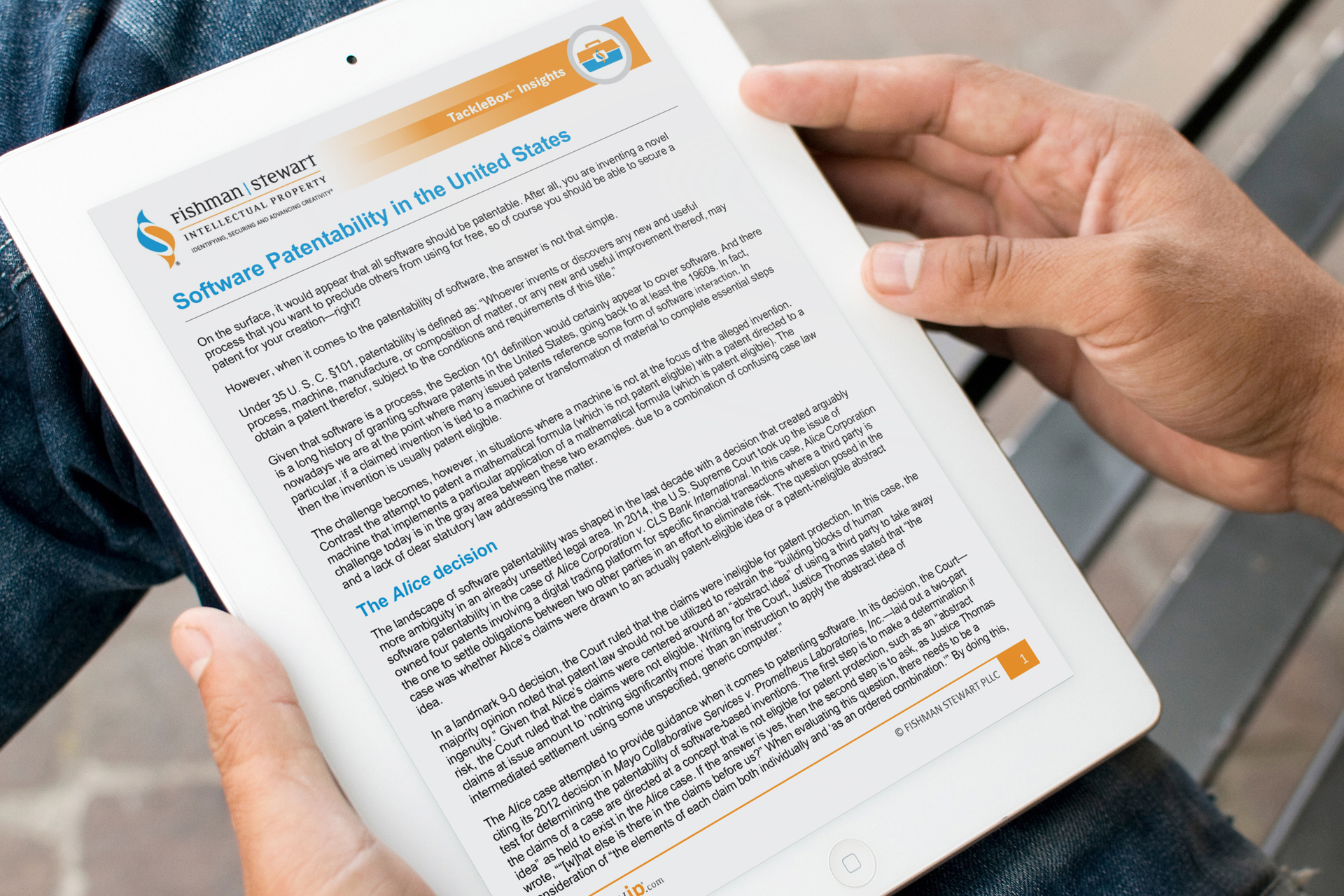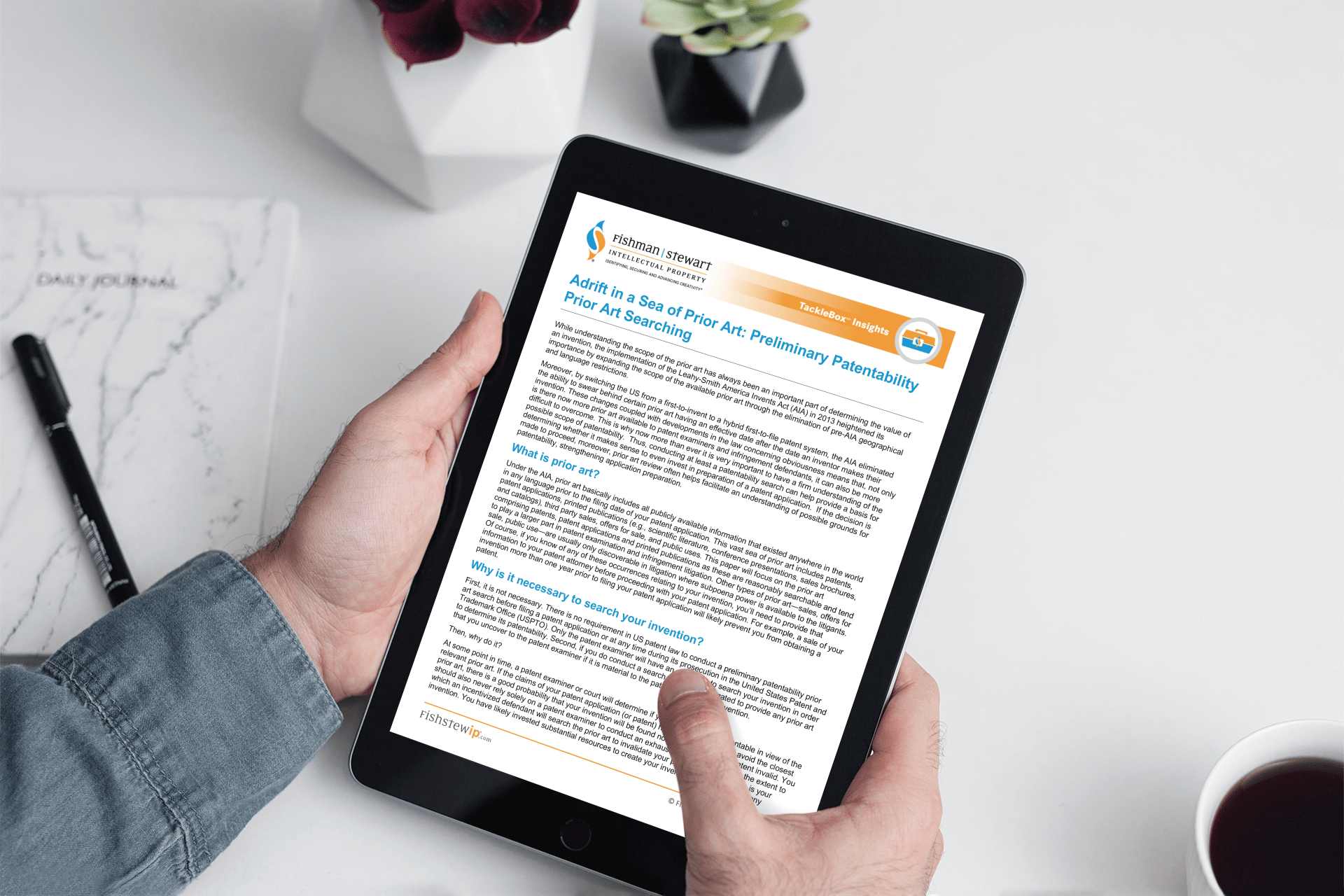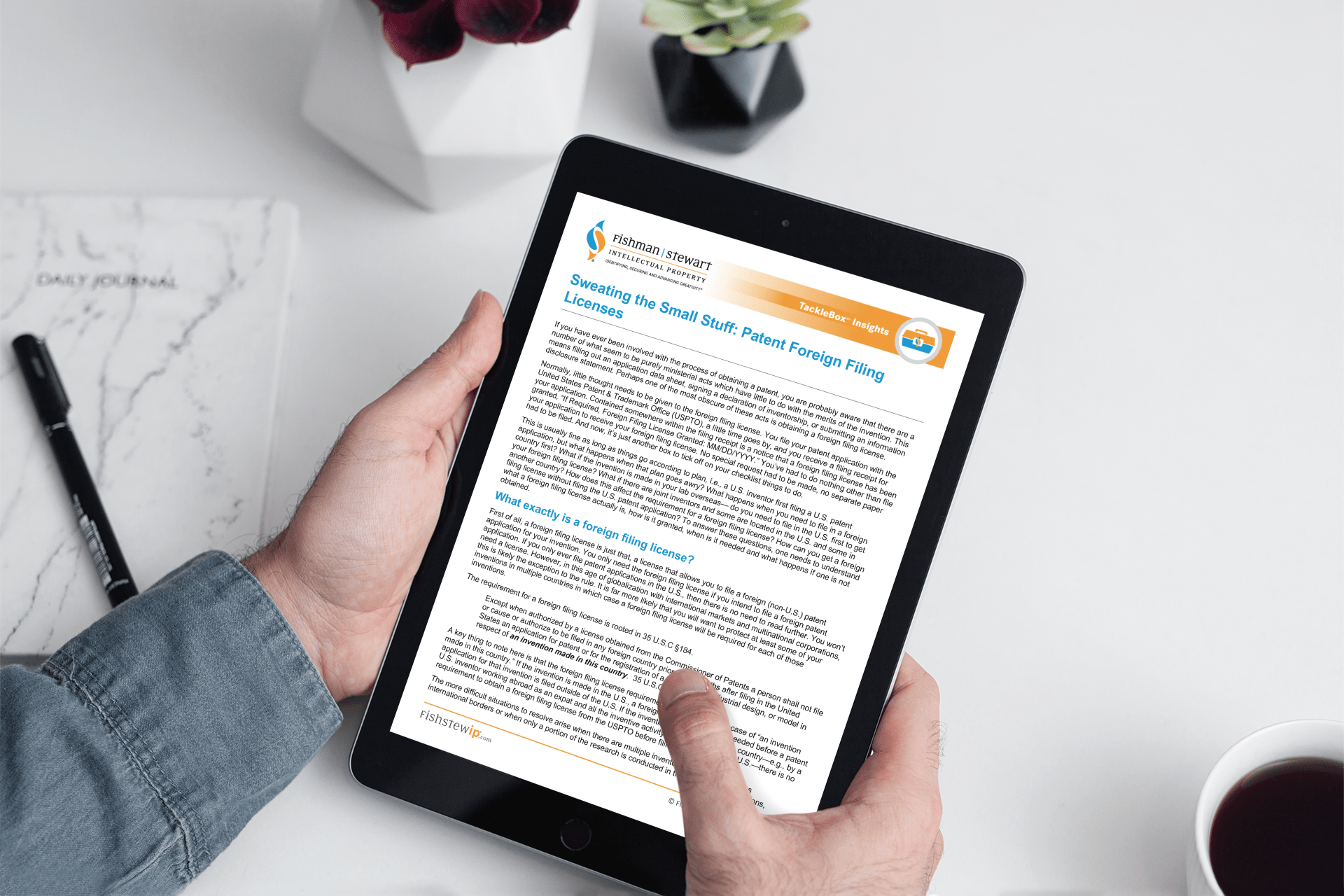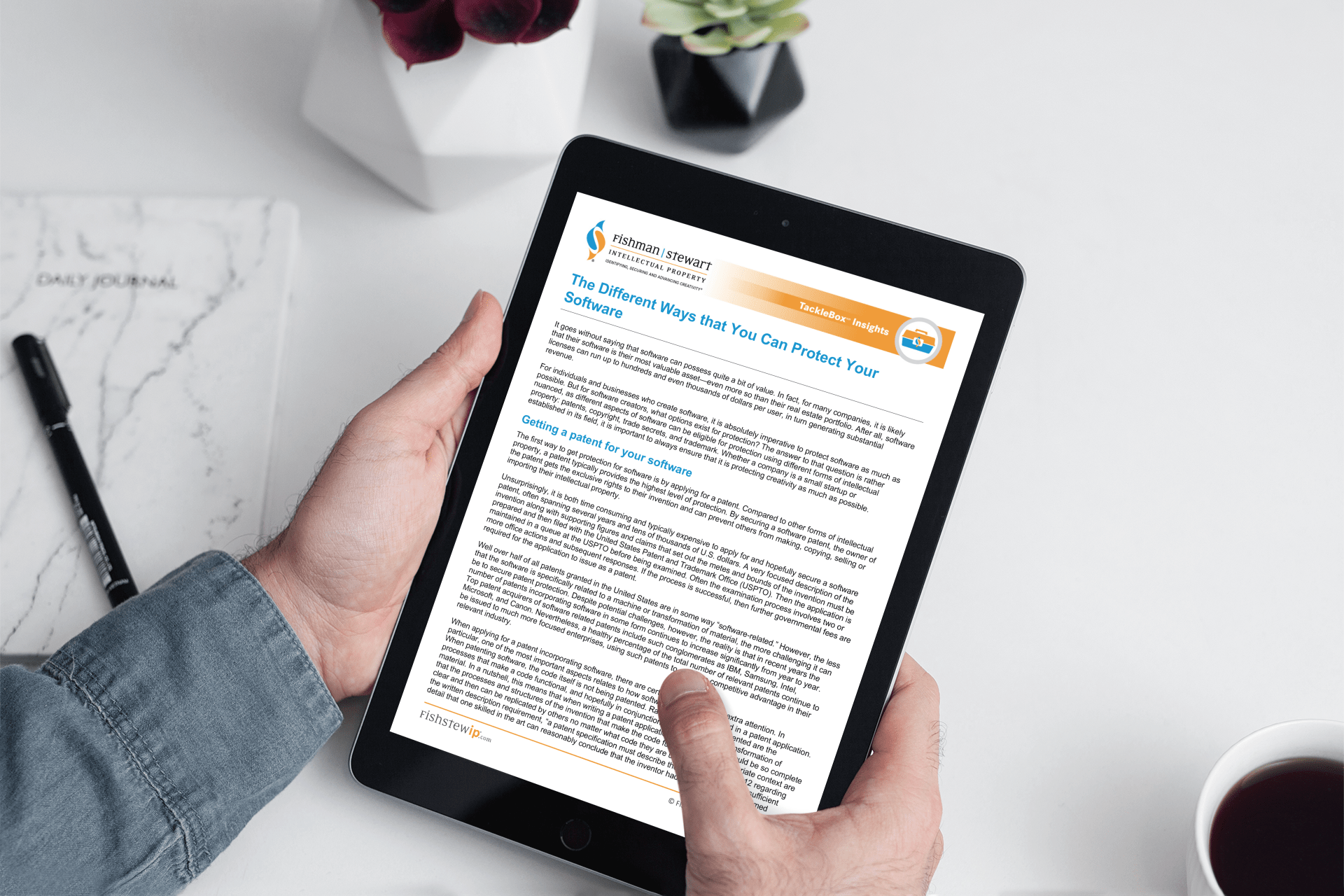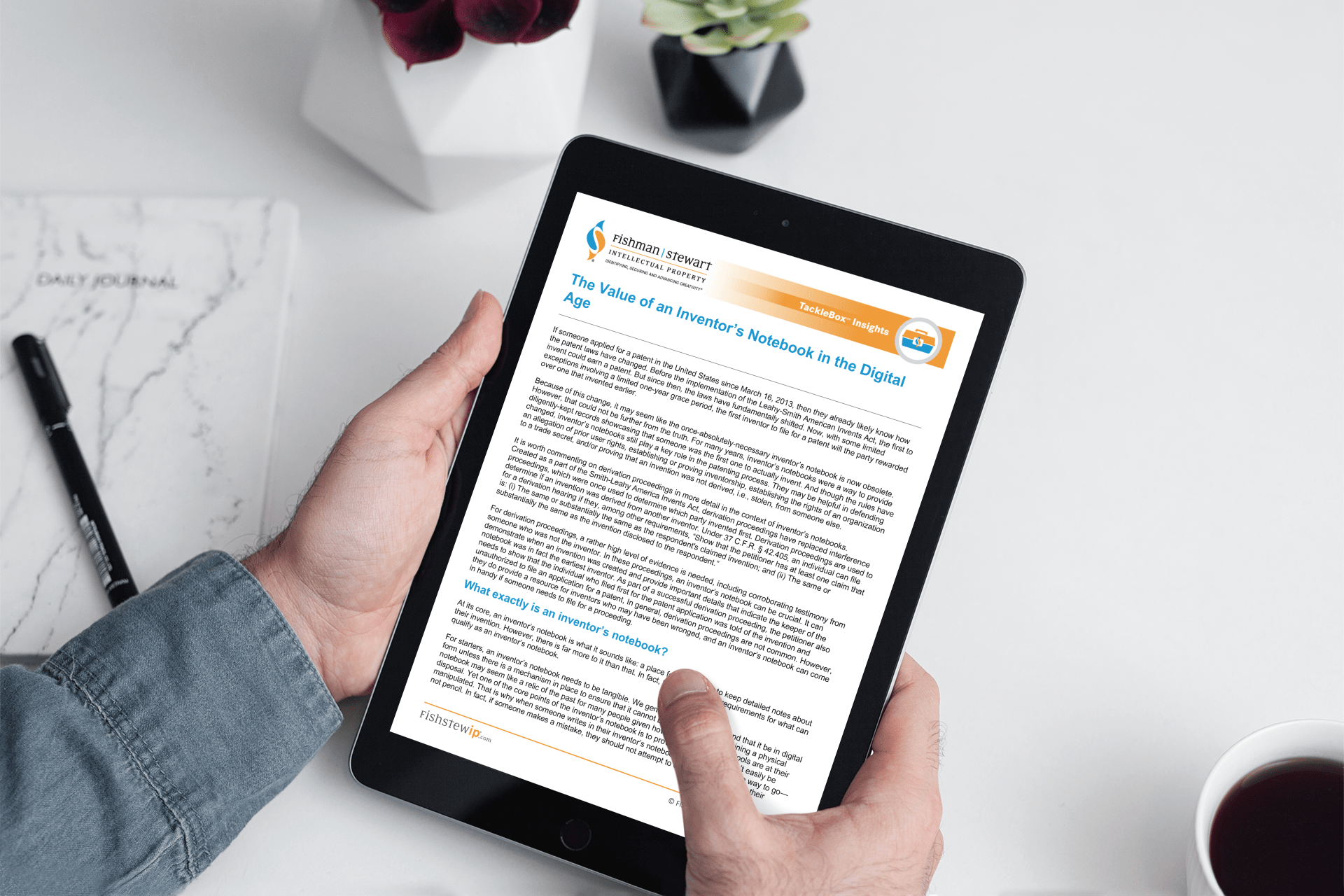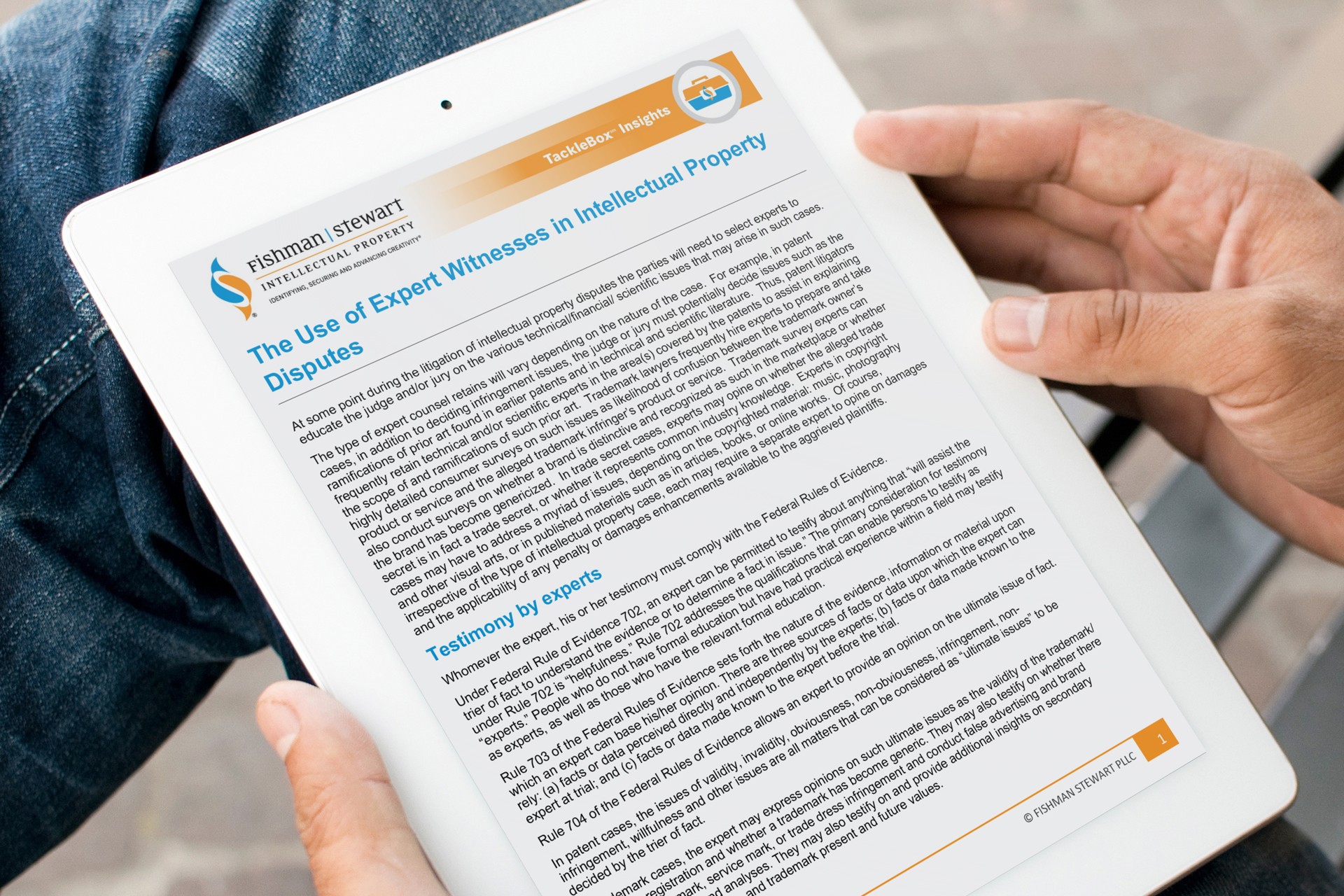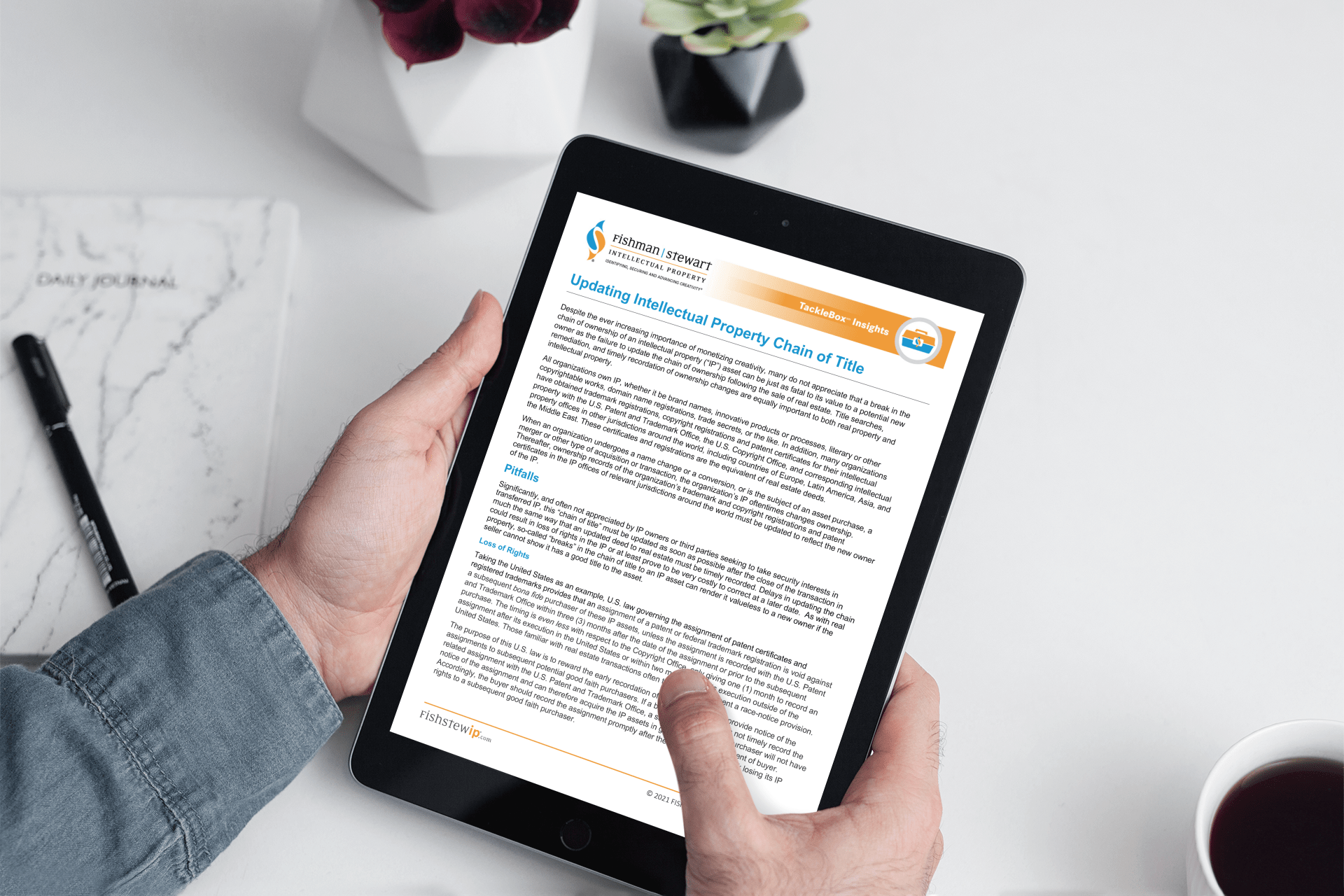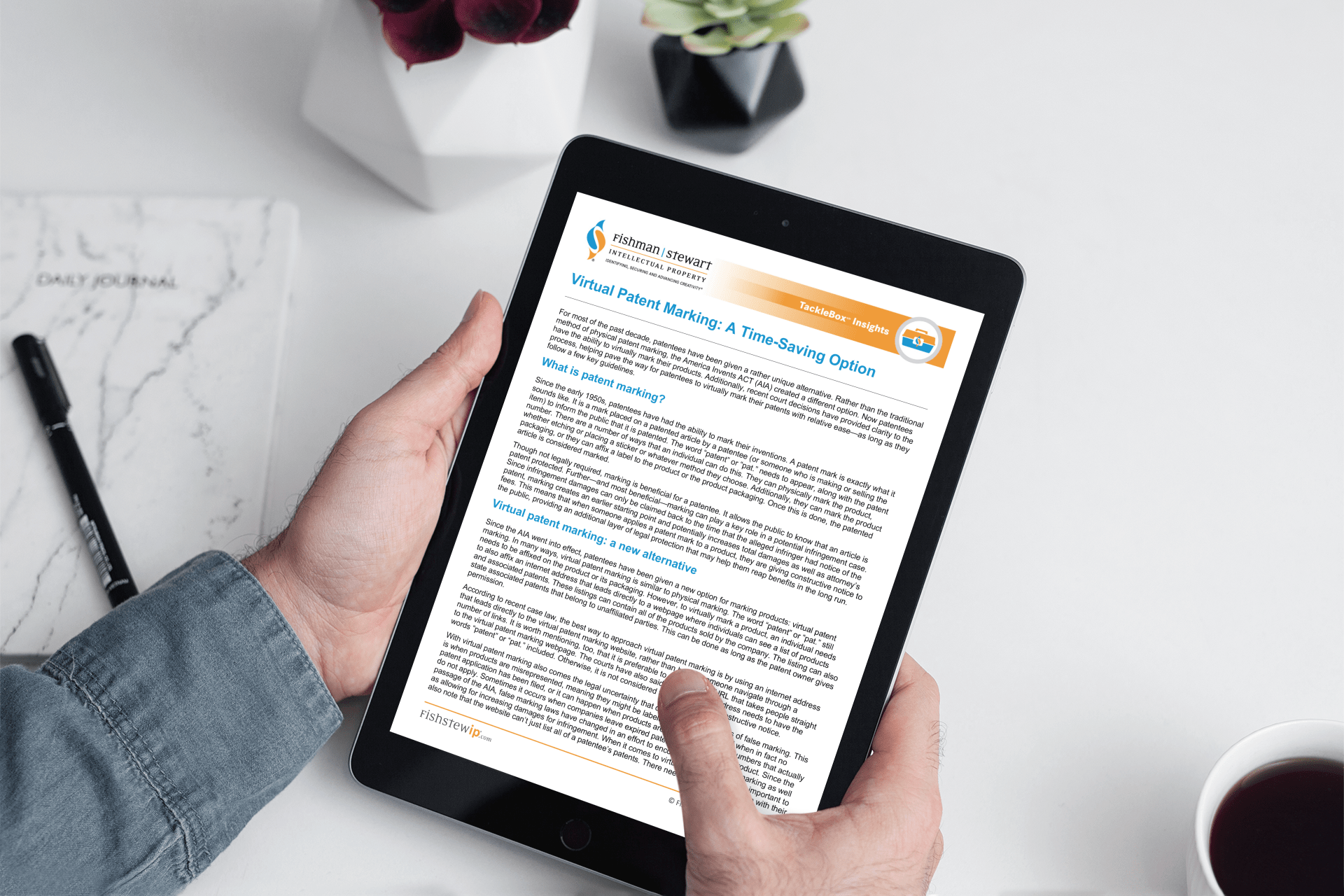Tacklebox® Insights
white Papers and other helpful tools
Casting for Success℠
- All
- Patents
- Trademarks
- Copyrights
- Trade Secrets
- Business Consulting
- Registrations and Certificates
- Transactions and Licensing
- Litigation and Dispute Resolution
- Internet and eCommerce
- Checklists and Forms
Ongoing Duty to Disclose Relevant Prior Art
There is a duty of candor and good faith which is owed to the United States Patent and Trademark Office (“USPTO”) at the time of filing and throughout the entire patent prosecution process until a patent is granted.
Continued Improvements and Filing Multiple Provisional Patent Applications
A provisional application can be a very useful tool for inventors when used properly. Prior to preparing a utility patent application, an inventor may first consider filing a provisional application
What To Do If You Are Accused of Trade Secret Theft
Allegations of trade secret misappropriation can arise in any number of settings. A common one is the employment context, where an employee may be accused by a former employer of stealing information and/or the employee’s new employer may be accused of unlawfully soliciting, receiving, or using the information.
Trademark Modernization Act
Last year, the U.S. Congress passed the Trademark Modernization Act. The resulting changes to U.S. Patent and Trademark Office practice take effect on December 18, 2021. The TMA will provide new tools to remove unused registered trademarks from the federal trademark register.
The IP Snapshot Program
As part of its due diligence legal services, Fishman Stewart announces its new IP SnapshotSM program, which provides a timesaving, insightful report for businesses, strategic enterprises, PE, VC, angel fund managers, and investment bankers.
Federal Trademark Registration Classes
When filing a trademark or service mark application with the U.S. Patent and Trademark Office (“USPTO”), selecting suitable, corresponding classes of goods and/or services can save time and money.
Why Was My US Filed Patent Application Rejected Because Of ‘Prior Art’
During the substantive examination of a US filed patent application, an examiner at the United States Patent and Trademark Office (“USPTO”) reads the application and determines whether the application follows various formal requirements.
Recording Trademarks And Copyrights With U.S. Customs & Border Protection
In 2020, U.S. Customs and Border Protection (CBP) seized approximately $1.3 billion worth of counterfeit goods being illegally imported in the United States.
Trademark And Service Mark Usage
Did you know that trademark or service mark rights can be lost through non-use or misuse? This is an important reason for trademark and service mark owners to be familiar with best practices for proper use of their marks.
From Idea to US Utility Patent - An Overview
Applying for and ultimately receiving a US utility patent can be very worthwhile. A granted US utility patent includes a bundle of property rights.
Unauthorized Resale of Goods
Particularly in the world of online retail, companies struggle with the unauthorized sale of their products. Unauthorized sellers often price cut.
Building a Case for Trade Secret Misappropriation
A former U.S. Attorney General once said: “There are only two categories of companies affected by trade-secret theft: those that know they’ve been compromised and those that don’t know yet.”
Principal Register and Supplement Register
Under United States trademark law, there are two registers of the United States Patent and Trademark Office (“USPTO”) on which marks can be registered: the Principal Register and the Supplemental Register.
Artisan Agreement
Access the Fishman Stewart Artisan Agreement.
Extracting Enterprise Value from Organizational Creativity
In 1975 tangible assets (i.e., real property) such as buildings and equipment, cash and bonds, inventory, and land represented 83% of the total value of the companies making up the S&P 500.
State-Legal Cannabis Trademark Protection Guide
Cannabis businesses are booming all over the United States. As these businesses are established, it is essential that brand owners protect their trademarks.
Three Commandments for Litigants
So, you landed in a legal dispute. Perhaps you found it necessary to sue a company or an individual. Perhaps someone has filed a lawsuit against you. Or perhaps no one has filed suit yet, but you see the potential for litigation on the horizon.
Trademark Application Filing Bases
In addition to listing the full legal name of the applicant, as well as its status (corporation, limited liability company, etc.) and its current address, a United States trademark application must include at least one basis for filing.
Why Should I Conduct a Trademark Search?
Developing a new brand and launching a new product or line of products are exciting times. In a rush to put goods or services on the market, and come up with the perfect tag line, slogan, or brand name, it is easy to become confused about what type of trademark search you should do—or even skip performing a search altogether.
Maintaining a U.S. Utility Patent: What are Maintenance Fees?
Whether you have already secured a U.S. patent, or are just now beginning the application process, it is important to understand your long term obligations to the United States Patent and Trademark Office (in order to keep your patent valid, and to remain in full compliance with regulations.
How to Fight Counterfeiters on Amazon
Your brand is everything: an identity, a reputation, and a revenue-generating asset. When your brand suffers, the bottom line suffers too.
Large, Small Micro Entities: Determining Your Status as a United States Patent Applicant and Patent Owner
Between application and maintenance fees, filing for a patent in the United States can be an expensive process.
How Marks (Trademarks and Service Marks) Act as Source Identifiers
What is the difference between a trademark and a service mark?
Patent Checklist
Access the Fishman Stewart patent checklist
Trademark Checklist
Access the Fishman Stewart trademark checklist
Copyright Checklist
Access the Fishman Stewart copyright checklist
Trade Secret Checklist
Access the Fishman Stewart trade secret checklist
Acceptable Federal Trademark Registration Specimens Of Use
Meeting the United States Patent and Trademark Office (USPTO) specimen requirements.
Designing an Effective In-house Patent Program
Often, a company’s most valuable asset is not its real estate, inventory, or other hard assets. Instead, the most valuable asset is the company’s patent portfolio.
Exemplary Invention Disclosure Form
The enclosed invention disclosure form is to be used for disclosing all inventions, discoveries, improvements or innovations, whether or not considered patentable to Fishman Stewart PLLC.
Developing A Comprehensive Patent Strategy
A comprehensive patent strategy that is properly and purposefully executed can provide enormous value to your company.
Capturing Inventor Creativity — Facilitating A Smoother Patent Application Process
Right before the patent application process kicks off, there should always be a meeting between the inventor and the patent attorney.
Innovation Protection During A Pandemic
Did your company create any innovative solutions during the 2020 Covid-19 Pandemic?
Intellectual Property Department Strategy
Intellectual Property (IP) in general encompasses the four major areas of patents, trademarks, copyrights and trade secrets.
Intellectual Property Risks In Reshoring Manufacturing Back To The U.S.
In 2020 and 2021, as disruptions from the coronavirus pandemic unfolded and there continued to be disruptions in global supply chains.
Intellectual Property Security Interests In The U.S.
Many people are familiar with the different types of property that can be the subject of a secured transaction, whether a bank has an interest in someone’s home or a credit agency takes an interest in an individual’s car.
Inventorship And Patent Ownership In The U.S.
Inventorship and patent ownership in the United States are different concepts covered by different bodies of law. While inventorship is a legal determination made under federal law, patent ownership is generally a factual determination made under state law.
Measures To Protect Intellectual Property Rights On Social Media
Having a robust social media presence is a must for modern businesses. It is a fast and easy way to reach hundreds or thousands of people just with the click of a button.
Non-Disclosure Agreements And Legal Counsel Representation
When someone wishes to discuss a matter that they consider highly confidential with a potential attorney, such as when an inventor is ready to seek patent protection, they will typically reach out to an attorney to guide them through the ins and outs of the process.
Software Patentability In The U.S
On the surface, it would appear that all software should be patentable. After all, you are inventing a novel process that you want to preclude others from using for free, so of course you should be able to secure a patent for your creation—right?
Preliminary Patentability Prior Art Searching
While understanding the scope of the prior art has always been an important part of determining the value of an invention, the implementation of the Leahy-Smith America Invents Act (AIA) in 2013 heightened its importance by expanding the scope of the available prior art through the elimination of pre-AIA geographical and language restrictions.
Steps An Organization Should Take To Protect Confidential Information
Confidential information defines organizations and is what sets them apart from their competitors, whether it is business plans, personnel records, trade secrets, patent applications, or consumer research.
Sweating The Small Stuff — Patent Foreign Filing Licenses
If you have ever been involved with the process of obtaining a patent, you are probably aware that there are a number of what seem to be purely ministerial acts which have little to do with the merits of the invention.
The Different Ways That You Can Protect Your Software
It goes without saying that software can possess quite a bit of value. In fact, for many companies, it is likely that their software is their most valuable asset—even more so than their real estate portfolio.
The Difference Between Mediation And Arbitration
People, including lawyers, frequently conflate arbitration and mediation as interchangeable. If you do that too, you are wrong.
The Value Of An Inventor's Notebook In The Digital Age
If someone applied for a patent in the United States since March 16, 2013, then they already likely know how the patent laws have changed. Before the implementation of the Leahy-Smith American Invents Act, the first to invent could earn a patent.
The Use Of Expert Witnesses In Intellectual Property Disputes
At some point during the litigation of intellectual property disputes the parties will need to select experts to educate the judge and/or jury on the various technical/financial/ scientific issues that may arise in such cases.
Updating Intellectual Property Chain Of Title
Despite the ever increasing importance of monetizing creativity, many do not appreciate that a break in the chain of ownership of an intellectual property (“IP”) asset can be just as fatal to its value to a potential new owner as the failure to update the chain of ownership following the sale of real estate.
Virtual Patent Marking — A Time-Saving Option
For most of the past decade, patentees have been given a rather unique alternative. Rather than the traditional method of physical patent marking, the America Invents ACT (AIA) created a different option.
You Snooze, You Lose - Identifying And Securing Creativity
Intellectual Property is a product of the mind and human intellect and recognized by our nation’s founders as crucial to the ongoing success of the United States.


